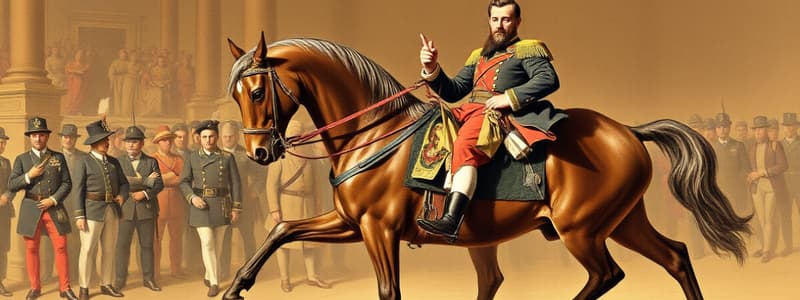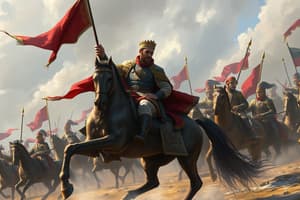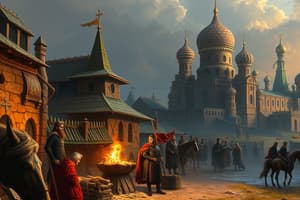Podcast
Questions and Answers
What was one of the primary aims of Alexander II's domestic policies?
What was one of the primary aims of Alexander II's domestic policies?
- Modernise the Russian military (correct)
- Strengthen autocracy through serfdom
- Increase feudal privileges
- Limit education reforms
Which of the following was NOT an aim of Alexander II's domestic policies?
Which of the following was NOT an aim of Alexander II's domestic policies?
- Maintain autocracy
- Catch up with the West economically
- Expand serfdom in rural areas (correct)
- Create a stable Russia after serfdom
Why did Alexander II feel the need to modernise the Russian military?
Why did Alexander II feel the need to modernise the Russian military?
- To catch up with the western powers after the Crimean War (correct)
- To expand the Russian Empire into Western Europe
- To prepare for a peaceful coexistence with neighboring states
- To recover from the loss against Napoleon
Which reform was essential for achieving the aim of modernising the military?
Which reform was essential for achieving the aim of modernising the military?
How did Alexander II's military reforms influence other sectors?
How did Alexander II's military reforms influence other sectors?
What was the relationship between Alexander II's aim to create a stable Russia and the abolition of serfdom?
What was the relationship between Alexander II's aim to create a stable Russia and the abolition of serfdom?
Which reform aimed at transforming local government was part of Alexander II's broader goals?
Which reform aimed at transforming local government was part of Alexander II's broader goals?
What was the context that prompted Alexander II to implement extensive reforms across various sectors?
What was the context that prompted Alexander II to implement extensive reforms across various sectors?
What was one economic reform Alexander II implemented to modernize Russia?
What was one economic reform Alexander II implemented to modernize Russia?
What was one of Alexander II's main goals in enacting reforms?
What was one of Alexander II's main goals in enacting reforms?
Which aspect of society did Alexander II focus on to prevent instability after the abolition of serfdom?
Which aspect of society did Alexander II focus on to prevent instability after the abolition of serfdom?
How did Alexander II’s military reforms primarily affect the serfs?
How did Alexander II’s military reforms primarily affect the serfs?
What did Alexander II hope to achieve by strengthening the military?
What did Alexander II hope to achieve by strengthening the military?
What was a measure taken to control the newly freed serfs?
What was a measure taken to control the newly freed serfs?
What was the purpose of the legal reforms implemented by Alexander II?
What was the purpose of the legal reforms implemented by Alexander II?
What action did Alexander II consider after facing assassination attempts?
What action did Alexander II consider after facing assassination attempts?
Which of the following statements about Alexander II's approach to reforms is accurate?
Which of the following statements about Alexander II's approach to reforms is accurate?
What was a consequence of Alexander II's reforms concerning the zemstvo and duma?
What was a consequence of Alexander II's reforms concerning the zemstvo and duma?
What was a significant reason for Russia needing a strong modern economy during the reign of Alexander II?
What was a significant reason for Russia needing a strong modern economy during the reign of Alexander II?
How did the failure of the transportation system impact Russia during the Crimean War?
How did the failure of the transportation system impact Russia during the Crimean War?
What educational reform did Alexander II implement to improve military leadership?
What educational reform did Alexander II implement to improve military leadership?
What was a key disadvantage of the Russian army during the 1855 conflict?
What was a key disadvantage of the Russian army during the 1855 conflict?
What economic conditions did Russia have at the start of the Crimean War?
What economic conditions did Russia have at the start of the Crimean War?
What role did railways play in Alexander II's military strategy?
What role did railways play in Alexander II's military strategy?
Why was the Junker School model significant for Russia's military?
Why was the Junker School model significant for Russia's military?
What significant change did Alexander II make to improve soldier morale?
What significant change did Alexander II make to improve soldier morale?
What economic strategy did Alexander II employ to modernize Russia?
What economic strategy did Alexander II employ to modernize Russia?
What aspect of military training did Alexander II recognize was lacking compared to Western armies?
What aspect of military training did Alexander II recognize was lacking compared to Western armies?
What was a consequence of the outdated economic practices before Alexander II's reforms?
What was a consequence of the outdated economic practices before Alexander II's reforms?
What innovation was important for the logistics of the Russian military?
What innovation was important for the logistics of the Russian military?
The success of the Russo-Turkish War was partially attributed to which reform?
The success of the Russo-Turkish War was partially attributed to which reform?
What was the military situation in Russia prior to Alexander II's reforms?
What was the military situation in Russia prior to Alexander II's reforms?
Flashcards are hidden until you start studying
Study Notes
Aims of Alexander II’s Domestic Policies
- Sought a strong and stable Russia post-serfdom; recognized the need for extensive reforms across various societal sectors.
- Central aims included military modernization, economic advancement, stability after serfdom, and maintenance of autocratic governance.
Modernization of the Russian Military
- Following defeat in the Crimean War, identified urgent need to modernize military capabilities to match Western powers.
- Linked military reforms to broader societal changes, recognizing that an effective army reflects its social structure.
- Aimed to enhance army through improvements in economy, transport, education, and military organization.
Economic Reforms
- Required a robust economy to fund military modernization; influenced by Industrial Revolution advancements from the West.
- Noted significant decline in Russia’s economic position by the 1850s; aimed to revitalize through reforms like tariffs, an extensive railway network, and state involvement.
- Established a modern banking system and attracted foreign investment to drive industrialization and partnership with global powers, ensuring Russia's standing as a Great Power.
Transportation System Enhancement
- The Crimean War exposed shortcomings in supply and transport logistics; aimed to construct a reliable railway system.
- Railways were critical for economic growth and military deployment, facilitating troop movement and resource distribution during conflicts.
Education Improvements
- Acknowledged need for better military education; established Junker Schools in 1864 to train officers similarly to Western military academies.
- Aimed to create a more effective army by fostering education and training, allowing for better leadership and tactical execution.
Army Organization and Service Reforms
- Recognized harsh conditions and long conscription periods as deterrents for recruitment; aimed to attract a willing and motivated military.
- Implemented measures to improve service conditions and gradually lessen burdens on serfs conscripted into the army.
Stability After Serfdom
- Emancipation of serfs initiated in hopes of reducing societal unrest and maintaining loyalty to the crown.
- Developed control measures, such as redemption payments and constraints via the mir, to manage newly freed serfs and prevent mass migrations that could destabilize Russia.
Maintenance of Autocracy
- Central aim was to preserve autocratic rule, viewing military strength, economic stability, and serf loyalty as essential to his longevity in power.
- Legal reforms intended to enhance public trust in autocracy; changes in court systems and handling politically sensitive cases reinforced his authority.
- Temporary reforms in response to social unrest reflected attempts to maintain control amidst growing discontent.
Overall Impact
- Achieved some reforms but faced ongoing challenges in ensuring successful implementation and maintaining authority amid evolving societal dynamics.
- Reflects a complex interplay between reform initiatives and the underlying goal of preserving traditional autocratic structures within the Russian Empire.
Studying That Suits You
Use AI to generate personalized quizzes and flashcards to suit your learning preferences.




